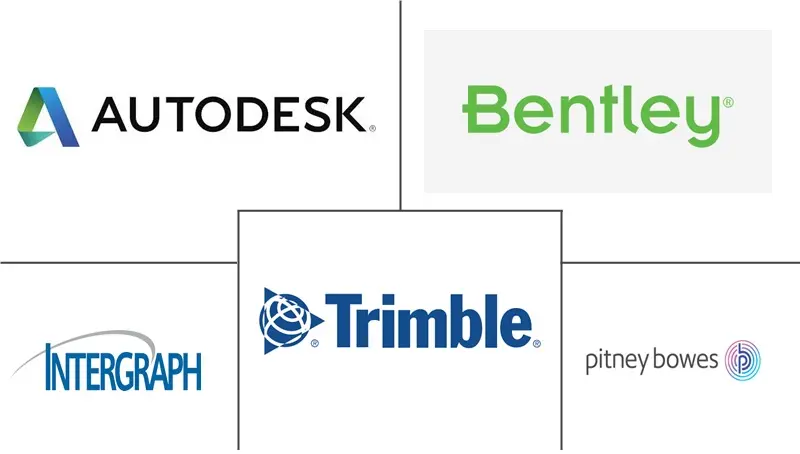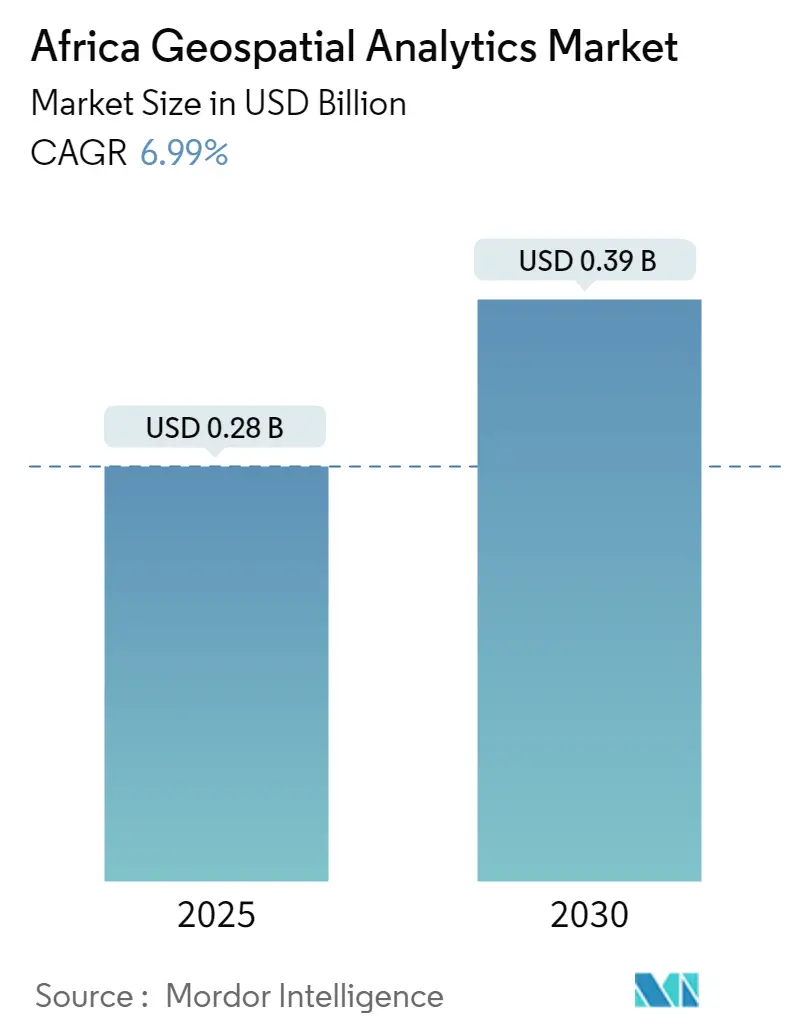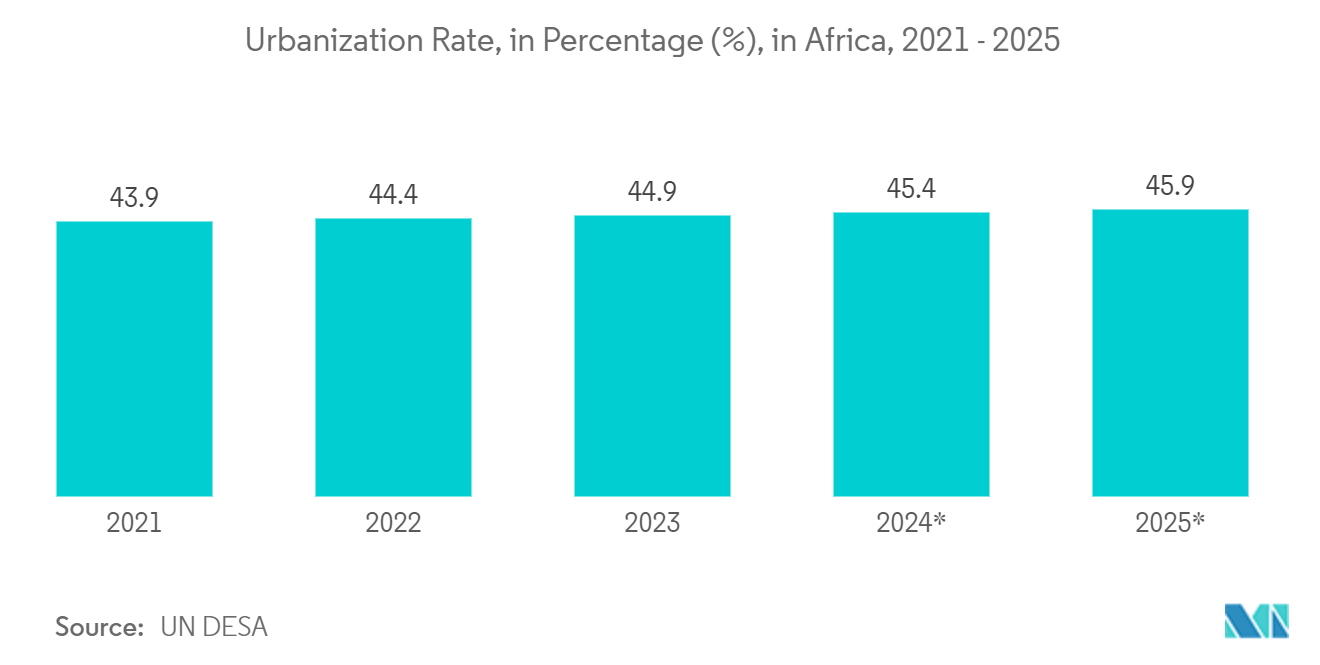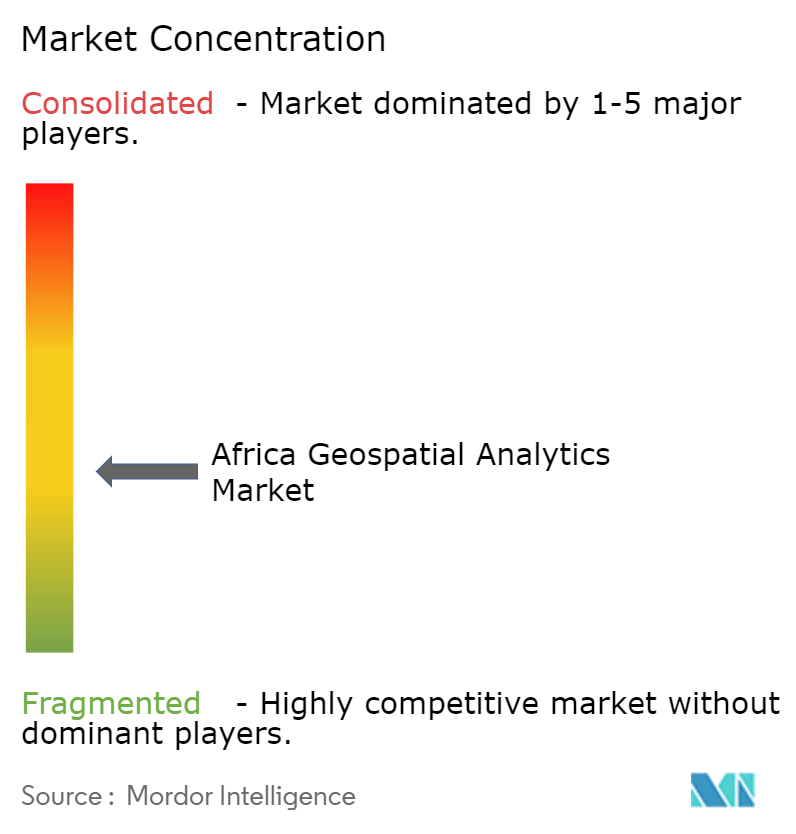Africa Geospatial Analytics Market Analysis
The Africa Geospatial Analytics Market size is estimated at USD 0.28 billion in 2025, and is expected to reach USD 0.39 billion by 2030, at a CAGR of 6.99% during the forecast period (2025-2030).
- The increased usage of modern technologies like remote sensing, GIS (Geographic Information System), and GPS (Global Positioning System) across numerous industrial verticals has led to substantial expansion in the Africa geospatial analytics market in recent years. In order to gain knowledge and make informed decisions, geospatial analytics refers to gathering, analyzing, and interpreting geospatial data.
- Geospatial analytics is increasingly valued by governments in many African nations for resource management and sustainable development. For instance, the African Union introduced the African Space Policy and Strategy, which aims to leverage space science and technology for socioeconomic development, including applications for geospatial analytics.
- Geospatial analytics is widely employed for precision farming, crop monitoring, land management, and yield optimization because agriculture is essential to Africa's economy. Businesses use advanced analytics and satellite images to give farmers real-time data on crop health, soil moisture, and meteorological conditions, empowering them to make data-driven decisions.
- In African cities, population growth and rapid urbanization have heightened the need for adequate infrastructure management and urban planning. For instance, the city of Nairobi in Kenya has implemented a geospatial analytics platform to track traffic jams, manage transportation routes, and enhance urban mobility in general.
Africa Geospatial Analytics Market Trends
Commercialization of Spatial Data
- The availability and accessibility of spatial data in Africa have considerably expanded as a result of the development of satellite technology and the spread of remote sensing devices. For instance, organizations like the African Regional Data Cube offer free access to satellite imaging data, allowing companies to use geospatial analytics without incurring large up-front fees.
- The demand for geospatial analytics has increased due to the rising use of mobile applications and location-based services (LBS). For instance, geospatial analytics are widely used by ride-hailing businesses like Uber and Bolt to connect drivers with passengers, optimize routes, and boost overall service effectiveness.
- Agriculture and natural resource management techniques in Africa are changing due to the commercialization of spatial data. Precision agricultural solutions are being offered to farmers by businesses employing satellite imaging, weather information, and soil data.
- Increased production and resource efficiency result from these technologies, aiding irrigation optimization, crop health monitoring, soil fertility assessment, and prompt intervention. For instance, businesses like aWhere and Syecomp provide geospatial analytics tools designed specifically for African farmers, giving decision-makers useful information.
- The commercialization of spatial data is driving the adoption of geospatial analytics in the insurance sector in Africa. Insurance firms use spatial data to evaluate and reduce the risks associated with natural disasters like floods, droughts, and wildfires. Geospatial analytics aids insurers in premium calculation, speedy claim settlement processes, and precise estimation of the exposure of covered assets to potential threats.
Increased smart city & infrastructure projects
- African governments and local authorities are developing innovative city projects to raise sustainability, boost livability, and promote economic development. For instance, the South African city of Cape Town has used geospatial analytics to track water use, improve distribution, and deal with challenges related to water scarcity.
- Geospatial analytics is essential for the administration and planning of mobility in smart cities. African cities like Lagos, Nigeria, and Nairobi, Kenya, have used geospatial analytics to assess traffic flow, improve public transportation, and implement traffic management strategies.
- In smart cities, geospatial technology monitors and controls utilities, including water, power, and waste management systems. Geospatial analytics, for instance, are used in Johannesburg, South Africa, to monitor power distribution and identify electricity theft or unauthorized connections.
- Geospatial analytics improves resilience planning in smart cities and aids in evaluating environmental conditions. Geospatial analytics, for instance, has been used in African cities like Accra, Ghana, to identify flood-prone areas, create early warning systems, and enhance disaster response planning. According to the World Bank, Africa's urban population is expected to quadruple by 2050, underscoring the need for effective and long-lasting infrastructure development.
Africa Geospatial Analytics Industry Overview
The Africa Geospatial Analytics Market is semi consolidated because of the presence of several companies. Some key players are Autodesk, Bentley Systems, Intergraph (Hexagon AB), Trimble Geospatial, Pitney Bowes Inc., etc. Key players in this market are introducing new innovative products and forming partnerships and collaborations to gain competitive advantages.
Africa Geospatial Analytics Market Leaders
-
Autodesk, Inc.
-
Bentley Systems, Inc.
-
Intergraph (Hexagon AB)
-
Trimble Geospatial
-
Pitney Bowes Inc.
- *Disclaimer: Major Players sorted in no particular order
Africa Geospatial Analytics Market News
- September 2024: Bayanat, a company in AI-driven geospatial solutions, has teamed up with Vay, renowned for its automotive-grade teledriving (remote driving) technology. Together, they've inked a Memorandum of Understanding (MoU) to enhance teledriving solutions by integrating geospatial data and AI. This collaboration empowers Bayanat, in tandem with Vay, to introduce and broaden the reach of teledriving technology across the Middle East, Africa, and select nations in the Asia Pacific.
- May 2024: AfriGIS stands out as one of the pioneering geospatial solutions firms, providing verified and validated geospatial data on administrative boundaries tied to postal codes across Africa. AfriGIS has crafted a polygon dataset for 21,600 localities (towns) and 475,000 sub-localities (suburbs) in the last three years. This dataset can be enriched via API with overlays like points of interest, administrative boundaries, cadastral data, deeds, census data, street centrelines, etc.
Africa Geospatial Analytics Industry Segmentation
Geospatial analytics is acquiring, manipulating, and displaying imagery and data from the geographic information system (GIS), such as satellite photos and GPS data. The specific identifiers of a street address and a zip code are used in geospatial data analytics. They are used to create geographic models and data visualizations for more accurate trends modeling and forecasting.
The Africa Geospatial Analytics Market is segmented by type (surface analysis, network analysis, geovisualization), by end user vertical (agriculture, utility and communication, defence and intelligence, government, mining and natural resources, automotive and transportation, healthcare, real estate, and construction). The market sizes and forecasts are provided regarding value (USD) for all the above segments.
| By Type | Surface Analysis |
| Network Analysis | |
| Geo-visualization | |
| By End-user Vertical | Agriculture |
| Utility and Communication | |
| Defense and Intelligence | |
| Government | |
| Mining and Natural Resources | |
| Automotive and Transportation | |
| Healthcare | |
| Real Estate and Construction | |
| Other End-user Verticals |
Africa Geospatial Analytics Market Research Faqs
How big is the Africa Geospatial Analytics Market?
The Africa Geospatial Analytics Market size is expected to reach USD 0.28 billion in 2025 and grow at a CAGR of 6.99% to reach USD 0.39 billion by 2030.
What is the current Africa Geospatial Analytics Market size?
In 2025, the Africa Geospatial Analytics Market size is expected to reach USD 0.28 billion.
Who are the key players in Africa Geospatial Analytics Market?
Autodesk, Inc., Bentley Systems, Inc., Intergraph (Hexagon AB), Trimble Geospatial and Pitney Bowes Inc. are the major companies operating in the Africa Geospatial Analytics Market.
What years does this Africa Geospatial Analytics Market cover, and what was the market size in 2024?
In 2024, the Africa Geospatial Analytics Market size was estimated at USD 0.26 billion. The report covers the Africa Geospatial Analytics Market historical market size for years: 2019, 2020, 2021, 2022, 2023 and 2024. The report also forecasts the Africa Geospatial Analytics Market size for years: 2025, 2026, 2027, 2028, 2029 and 2030.
Our Best Selling Reports
Africa Geospatial Analytics Industry Report
Statistics for the 2025 Africa Geospatial Analytics market share, size and revenue growth rate, created by Mordor Intelligence™ Industry Reports. Africa Geospatial Analytics analysis includes a market forecast outlook for 2025 to 2030 and historical overview. Get a sample of this industry analysis as a free report PDF download.







